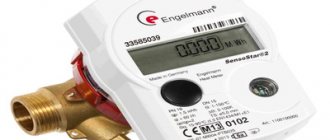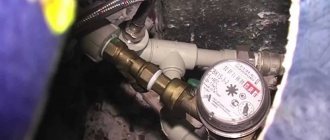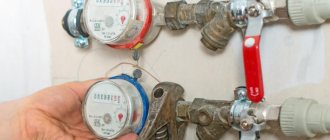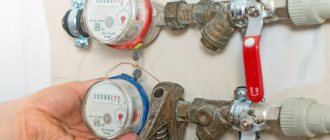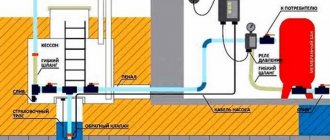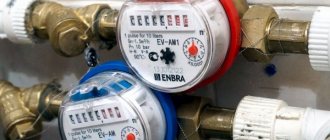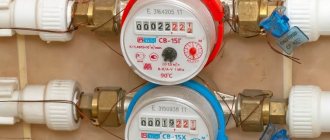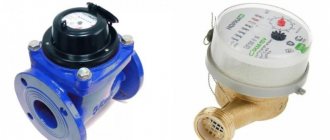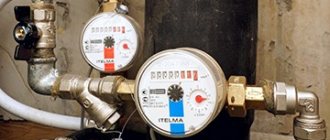A water meter is an important device that monitors water consumption in a home. This determines compliance with the rules of installation, as well as operation of the structure. It is to monitor compliance with these rules that seals are installed.
Sealing water meters is an important procedure that is subject to control by utility services. So, what is a seal, its purpose, the principle of installation, how many seals should there be and other issues will be discussed in detail below.
What it is?
Sealing is the installation of a disposable device on an individual metering device, confirming the integrity and serviceability of the IPU.
Serves to restrict access to device components in order to change readings , and prevents illegal replacement.
The use of seals is part of a set of measures aimed at ensuring reliable accounting of the amount of water consumed, regulated by a decree of the Government of the Russian Federation dated July 29, 2013. as amended on July 26, 2018. “...about water supply and sanitation.”
You can install water meters yourself or through authorized structures. Only organizations that have received a license to carry out such activities have the right to seal.
The sealing is carried out by suppliers of utility resources, management companies, housing offices, and may also be third-party organizations.
The need for filling arises in the following cases:
- the meter is installed for the first time;
- the device has been replaced due to a malfunction;
- installation work was carried out on the water supply line;
- accidental damage to the seal.
Attention! The validity period of the seal is not limited by law; replacement is necessary only if the integrity is damaged.
We recommend an article on the topic
What is the width of the Amur River, what factors influence its variability?
What to choose: checking the meter or replacing it?
The standard shelf life of this device is about 12 years. Modern inexpensive models can be used for only 4 years. But in fact, the exact period during which this technique can be used depends on the model, operating conditions, as well as the accuracy of the data provided. Hot water appliances have a shorter service life due to the fact that they are exposed to aggressive influences.
Experienced users argue that it is important to replace devices after 5 years, so it is more profitable to refuse periodic paid checks and replacement of seals. It is best to immediately purchase a new meter, which will be immediately sealed for free.
What if you don't put a seal on the water meter?
Is it possible to leave the IPU without a filling? Theoretically, yes, this does not directly contradict the law. But then the meaning of the mandatory installation of a meter is reduced to zero.
The readings of an unsealed device are not the basis for calculation.
In this case, consumption is calculated according to the consumption standard per person established for a given region, multiplied by the number of registered residents.
The amount turns out to be higher than calculated by the counter.
Answer
Re-sealing of metering devices is free. An exception is established only if the seal is broken by the consumer not for the purpose of repairing the meter. Since in your case the seal was broken for repairs, resealing will be free.
The rationale for this position is given below in the materials of the “Lawyer System”
.
Letter of the Federal Antimonopoly Service of Russia dated December 13, 2013 No. KA/50647/13 “Explanations on the possibility of charging fees for registration of individual metering devices”
“In accordance with Article 13 of the Federal Law of November 23, 2009 No. 261-FZ “On Energy Saving and on Increasing Energy Efficiency and on Amendments to Certain Legislative Acts of the Russian Federation” (hereinafter referred to as the Law on Energy Saving), produced, transmitted, consumed energy resources are subject to mandatory accounting using metering devices for energy resources used.
Part 9 of Article 13 of the Law on Energy Saving establishes that from July 1, 2010, organizations that supply water, natural gas, thermal energy, electrical energy or their transmission and whose engineering support networks have direct connection to the networks that are part of the engineering - technical equipment of facilities that are subject, in accordance with the requirements of this article, to be equipped with metering devices for used energy resources (hereinafter referred to as resource supply organizations), are obliged to carry out activities for the installation, replacement, operation of metering devices for used energy resources, the supply or transmission of which they carry out.
Thus, when determining business entities that are obliged, in accordance with the requirements of the Energy Saving Law, to carry out activities related to the installation, replacement and (or) operation of energy metering devices, it is necessary to simultaneously establish the mandatory presence of the following conditions:
— organizations supply or transmit water, natural gas, thermal energy, electrical energy;
— networks of engineering and technical support of organizations have a direct connection to the networks that are part of the engineering and technical equipment of facilities that are subject to being equipped with metering devices for energy resources used.
These organizations do not have the right to refuse persons who have applied to them to enter into an agreement regulating the conditions for the installation, replacement and (or) operation of metering devices for the energy resources used, the supply or transmission of which they carry out.
Order of the Ministry of Energy of the Russian Federation dated 04/07/2010 No. 149 approved the Procedure for concluding and essential terms of the agreement governing the conditions for the installation, replacement and (or) operation of metering devices for energy resources used (hereinafter referred to as the Procedure). The procedure for putting the installed meter into operation is an essential condition of such an agreement (clause 13 of the Procedure). In this case, the price of such an agreement is determined by agreement of the parties.
Meanwhile, in accordance with paragraph 5 of Article 20 of the Federal Law of December 7, 2011 No. 416-FZ “On Water Supply and Water Disposal” (hereinafter referred to as the Law on Water Supply and Water Disposal), water and wastewater meters are placed by the subscriber, the organization operating water supply or sewerage networks, at the border of the balance sheet of the networks, the border of the operational responsibility of the subscriber, the specified organizations or in another place in accordance with the agreements specified in Part 1 of Article 7, Part 1 of Article 11, Part 5 of Article 12 of the Law on Water Supply and Sanitation, connection agreements ( technological connection). Water and wastewater metering devices installed to determine the amount of water supplied to the subscriber under a water supply agreement, wastewater discharged by the subscriber under a water disposal agreement, are sealed by organizations that provide hot water supply, cold water supply and (or) wastewater disposal and with which the specified agreements have been concluded, without charging fees from the subscriber, except for cases when the sealing of the relevant metering devices is carried out by such an organization again due to the violation of the seal due to the fault of the subscriber or third parties.
What types of fillings are there?
A seal is a seal that is placed with a special stapler on the base that fastens the ends of the wire. It is threaded through the places where the meter is attached to the pipe on both sides. It is impossible to remove it without compromising its integrity. A protective mark and an individual seal number are imprinted on the base.
The following types of fillings are used:
- Lead, plastic. These are round parts made of soft material into which the ends of the wire are inserted and then clamped.
- Clamps. They are plastic staples with a specified individual number. They close in one direction and are impossible to remove without damaging them.
- Rotary locks. These are pieces of transparent plastic with special disposable inserts.
- Special stickers equipped with indicators. A control message appears when you try to dismantle the meter.
- Antimagnetic seals . Essentially the same stickers that record attempts to change meter readings using a magnet. Anti-magnetic seals are widespread, as cases of using magnets to distort the readings of control devices have become more frequent.
In the photo you can see what the meter looks like with an anti-magnetic seal installed:
How many should there be?
The number of IPU corresponds to the number of water supply lines. When the home is equipped with water heating devices, one device is installed on the cold water supply pipe.
With separate supply of hot and cold, there are two devices , one for each line. One seal is installed on it, attached in two places, the points of connection of the water meter with the pipe.
For this purpose, connecting ears with special holes for threading wire are used. If antimagnetic seals are used, there may be two of them. Installing such seals is an additional measure to ensure proper operation of the water meter.
Reference! The law does not directly oblige the owner of the device to install additional sealing devices, but does not prohibit their use by the service provider. The subscriber has no right to prevent the installation of additional seals.
In what case do you need to pay?
Existing legislation stipulates that sealing is performed free of charge if a new device is installed or a certified verification of water meters has been carried out.
Paid sealing is possible in the following cases:
- If the element is damaged due to the transfer of the connection point. The exception is the reconstruction of communications, which is carried out by the management company or HOA. But if the management organization does not have the right to put a seal, then before tearing off the old one, it is better to coordinate the actions.
- If the wire has rotted and the locking device has come off. Many performers restore this element only for money, since it is the consumer who is responsible for the safety of the meter. In such a situation, it is necessary that when carrying out control checks, the owner himself inspects the seal in advance and points out possible violations that have arisen due to the failure of the wire. The sealing element may fall off due to the fact that the contractor used low-quality and unsuitable fixing material.
- If the seal is damaged. Exceptions are the actions of employees of a management company, homeowners association or resource supply organization.
Attention! The element may fly off due to the fault of pets, so it is necessary to limit the area of their influence.
Should I pay or not for the procedure?
Until recently, if the first installation of the IPU was carried out by service providers, sealing was not paid for separately, it was included in the installation fee.
If the control device was installed on its own, water utility customer services demanded a fee for sealing, citing the fact that sealers cannot work for free.
To the point that they refused to accept meter readings for calculation without a receipt for payment for the sealing.
In accordance with paragraph 31 of the rules for the provision of utility services, the resource supplier cannot prevent the consumer from installing the IPU , and is also obliged, at the request of the consumer, to put the meter into operation.
Payments for utilities must be calculated according to meter readings starting on the first day of the month following the installation of the IPU
Thus, the initial sealing should be carried out free of charge . A fee may be charged for secondary sealing, which is necessary if the water meter is installed incorrectly, the device breaks down, or the integrity of the seal is damaged due to the fault of the owner. The amount ranges from 200 to 2000 rubles.
Read more about the cost of sealing in this article.
Who is responsible for sealing the electricity meter?
Electricity consumption meters are used to control energy consumption. The installed device must be sealed, which confirms its serviceability, functionality and integrity.
In addition, the seal protects the device from unauthorized interference in its operation. It is no secret that unscrupulous consumers often make changes to the device in order to change its readings.
Sealing of the electric meter is mandatory. But who seals electricity meters - the answer to this question is given below.
Types of fillings
The installed device has two seals:
Sealing is carried out in strict accordance with current legislative norms and rules.
Legislation on fillings
Government Decree No. 354 (March 27, 2021) in part 7, clause 81[2] states that the installation of an electric meter is the responsibility of the owner of the premises, no matter whether residential or non-residential. And putting it into operation is the responsibility of the electricity supplier in the same paragraph of the resolution.
From the above we can conclude that the consumer must install and seal the electric meter independently.
Yes, such installation is permitted by law. But is it necessary to install it yourself, much less seal at least one device, at least several electricity meters, if the installation requires the presence of a qualified specialist, and the sealing is carried out only by the supplier - this is his responsibility.
Appendix to the document
sample application for sealing a water meter.
Sealing procedure
During the initial installation of the device, its installation and sealing is carried out by the resource supplier. There is no charge for the work performed. The seal number is entered into the State Register. After this, the meter is placed on the balance sheet of the electricity supplier.
However, the owner of the premises in which it is installed is responsible for its safety.
A second filling can be installed in the following cases:
- the integrity of the seal is compromised;
- the faulty device was repaired;
- There were disagreements in the testimony.
The procedure is the same, but the documentation is different. The consumer writes a statement outlining the reasons for the secondary filling. Then it is carried out and a work completion certificate is drawn up, which is endorsed by both parties: the applicant and the contractor.
It is necessary to note one important point regarding certified electricity meters. Who should put seals on them? In this case, sealing is carried out if:
These measures are carried out when either malfunctions of the device, or inaccuracies or discrepancies in its readings are identified. In the first case, the seal can be installed by the supplier; in the remaining cases, the sealing is entrusted to the metrology and standardization service. Based on the results, a so-called verification seal is placed on the meter or a verification certificate is issued.
Fine for breaking or missing seal on the electric meter
For the absence of a seal on the electric meter or its breaking, a fine is imposed on the consumer in the amount of:
- from 300 to 1000 rubles per individual, provided that the meter data has not been adjusted;
- from the organization – 5,000 – 20,000 rubles.
(Administrative Code, Chapter 11, Articles 11.15 and 16.11).
In conclusion, it is worth saying that the need to control and account for electricity consumption is the responsibility of both the consumer and the supplier. Therefore, the installation, as well as the sealing of the meter, is not disputed. At the same time, it is important to take care of the device, maintain its integrity and the safety of the seals, since this is a guarantee against the collection of excessive money, as well as undesirable consequences.
Where to contact?
Only organizations that have a license to carry out this type of activity are granted the right to seal IPU.
For sealing, in most cases, you must contact the subscriber department of the water utility , the management company, the housing office or the homeowners association, if you have a meter maintenance agreement.
A seal by someone who is not licensed is illegal and is considered the same as not having a seal.
Important! Before starting work, it makes sense to make sure that the license of the representatives of the organization who came to seal the meter at the request of the subscriber has not expired.
Even more information about who seals meters can be found here.
Cost of work
Every residential owner is interested in the question of how much it costs to seal a water meter. This service is paid only for repeated implementation. If a new metering device is installed in an apartment, the seal must be installed free of charge based on legal requirements.
If the apartment owner damaged the equipment himself, he will have to pay a certain amount of money to install a new seal. The cost of the service may vary significantly in different regions. For example, you can seal water meters in Moscow for about 2 thousand rubles, while in other regions the cost of such a service is within 500 rubles.
How to install it yourself?
For this purpose, an algorithm of actions is provided to give it the official status of a measuring device.
- Installation of the meter in compliance with the requirements for the location of metering devices. The water meter must be accessible for maintenance, provide clear visualization of meter readings, be securely fastened and correctly oriented.
- Submitting an application to the water utility customer service, or an authorized company, for sealing the IPU.
The application contains:- personal data of the applicant;
water meter installation date;
- model, type, device number;
- meter readings;
- date of the next scheduled verification.
Coordination of the time of arrival of the master. The service must be provided within 15 calendar days from the date of application.- The arriving specialist checks the correct installation of the meter.
- Checking the availability of supporting documents.
- Installation of a seal on the IPU.
- Filling out the certificate of acceptance of the device into operation.
It is advisable to attach a copy of the IPU passport to the application. You can contact the official websites of organizations licensed to seal meters in electronic format.
The act specifies:
- name of the water supply supplier;
- Full name of the person who installed (if installed independently, checked and sealed) the meter;
- date of drawing up the act;
- Full name of the meter owner;
- device installation address;
- model, IPU number;
- meter readings;
- number of the seal (seals, if there are several of them).
The act is signed by all parties and drawn up in two copies. From this date, the meter is recognized as an official measuring device; according to its readings, the amount of water consumed is determined.
When is it necessary to seal an IPU?
Unlike an electricity meter, the water meter is located in a closed transparent case that cannot be removed, otherwise the control plastic ring will be damaged. In addition, modern cold and hot water meters are equipped with an anti-magnetic sticker. Such a seal responds to attempts to change the readings by exposure to electromagnetic waves (the substance spreads in a transparent capsule). If a sticker is accidentally or intentionally torn off, the word “Open” will appear on the surface when it is put back in place.
On a note! The presence of an antimagnetic element slightly affects the cost of the device, but eliminates any claims from the resource supplying organization in terms of deliberate influence on the device.
The final sealing of the water meter is carried out using a plastic numbered part. To do this, an employee of the relevant organization is called. The work does not directly affect the main part of the device, except for mechanisms without an anti-magnetic sticker. Sealing occurs between two control nuts, which serve to connect the device to the supply system.
This procedure is necessary in the following cases:
- Initial commissioning of a water meter in newly built private and apartment buildings.
- Completion of the period of use or return of the mechanism from a certified inspection. For cold water IPU, the period after the first verification is 6 years, for hot water – 4 years. If the DHW device is installed on cold water pipes, then the period is calculated based on the data specified in the commissioning certificate.
- Meter failure. The fact of damage is detected independently or during inspection by regulatory organizations.
- Replacement of valves and pipes (if work cannot be carried out without removing the device). This is especially true if the inlet ball valve fails.
- An emergency situation that required the rapid dismantling of the IPU or pipes.
- Cleaning filter clogged. If the supplied water contains coarse impurities, the mesh installed at the inlet gradually becomes clogged. To clean, you will need to remove the mechanism.
- Damage to the wire used to seal the device.
To avoid problems, you need to take into account the basic rule, which involves maintaining the integrity of the element used to seal the mechanism.
In case of any intervention in the operation of the water supply system, which entails complete or partial dismantling of the water meter, it is necessary to reseal the meter
The difference between an HOA and a management company when applying?
The difference between them is that the activities of the management company are commercial in nature. It is authorized to provide the population with a certain range of paid services.
Including sealing meters, if licensed for this. The HOA does not have a commercial focus, protects the interests of apartment owners , and can be the owner’s representative before providers of services and resources. The powers of the HOA are specified in the charter approved by its members.
If they have licenses and service contracts, any of them can seal the meter. Here considerations of convenience and the reputation of the service provider come to the fore.
Carefully! There are widespread cases of illegal charging for sealing, when installers took advantage of the ignorance of consumers. The price issue is added only with secondary sealing.
HVS
If there is a gas boiler or water heater in the house, then only cold water is supplied. In this case, only one water meter needs to be sealed. If there is a hot water supply, it is necessary to install a pair of meters, each of which must have a seal.
The meter for hot water is sealed in the same way as for cold water. There are no fundamental differences in installing a seal. The technician seals the water meter and issues the appropriate papers containing all the necessary data.
Do I need to seal it when replacing equipment?
Technically, the procedure is similar to that when the meter is installed for the first time. But there are differences.
If a malfunction is discovered, you must immediately notify the supervisory authority and attach a letter to the application indicating when and by whom the malfunction was discovered.
The arriving specialist draws up a dismantling report, which indicates the malfunctions, the causes of their occurrence, and records the meter readings.
Then, instead of the faulty device, a temporary insert is installed, which makes it possible to use the water supply during the period of replacement or repair of the meter. In the period from dismantling to installation of a new device, the calculation is based on average consumption over the last six months.
If a malfunction is detected by the controller, access to the device without the consumer is impossible, there are signs of unauthorized intervention in the device, recalculation is carried out from the date of sealing or the date of last verification (depending on what happened later) until the date of detection of the malfunction.
Important! The maximum period cannot exceed three months. The calculation is carried out according to the established consumption standard, multiplied by 10.
Duration of the procedure
Time intervals are also specified in RF PP No. 354, paragraph 81-81(2):
- The device is put into operation no later than the month following the installation date.
- After receiving the application, the contractor can agree on a new deadline. For this purpose, 3 days are given from the moment the notification is accepted. The postponement cannot be more than 15 days from the original date.
- If the contractor does not appear at the agreed time, then the device is considered to be put into operation from the moment the application is accepted. Although the law allows the use of IPU without a seal, it is necessary to contact the regulatory authorities so that the work is completed.
The water meter may not be put into operation if violations of the installation technology or non-compliance of the device with standards are discovered.
What are the risks of failure?
Failure of a seal is considered to be a violation of the integrity of the seal.
Characteristic signs of a breakdown are:
- complete destruction of the seal;
- cracks on the body;
- the appearance of a control inscription on the seal - sticker;
- The antimagnetic filling loses its color.
For breaking a seal, an administrative fine is provided, the amount of which is determined based on the severity of the violation.
The minimum fine is 200 rubles, imposed under the following conditions x:
the failure occurred unintentionally, and the regulatory authorities were informed about it in a timely manner;- during the period preceding the disruption, consumption did not change significantly;
- the controller had regular access to the device;
- the case of failure is isolated.
If these conditions are not met, the fine may be increased fivefold. The use of magnets and illegal insertion entail a fine of up to 300,000 rubles, and possible criminal prosecution.
Reference! If the seal is accidentally broken, you should immediately contact the management company or utility supplier, record the failure, and write a request to reseal the meter.
Even more information about what to do if the seal is broken can be found here.
Responsibility for a broken seal
For breaking the seal, the company may demand payment of an amount without taking into account the meter. The reference number is the date of filing the application or the last day of checking the meter.
The fine for a broken seal on a water meter is calculated as follows: the throughput of the water supply system is multiplied by the number of calendar days when the seal was not installed. This amount is paid by the owner.
If the seal was damaged accidentally, you need to proceed according to the following algorithm:
- write a statement about the fact that the seal was removed;
- apply for a new filling;
- wait for the inspector to arrive to reseal it.
The application must indicate the reason for the situation. The inspector will check the device and make a decision whether an illegal attempt was made to change the readings. Then he must replace the filling with a new one.
If no unauthorized access is detected during the preparation of the report, the owner will not have to pay a fine. In this case, the testimony must correspond to reality. Payment is made only for refilling.
The seal is an element for correctly calculating resource consumption. Plastic or metal products are used. The seal is attached to a wire, sometimes knots are tied on a fishing line behind the seal. The installation is carried out by special structures associated with water supply. Sealing is done free of charge if the owner himself was not the cause of the broken seal. The absence of a seal can result in high costs for water supply services. If the seal is accidentally broken, you should contact the appropriate services and write a statement.
Questions and answers on the topic
What will happen if the inspectors are not allowed in?
Utility service inspectors are required to regularly inspect apartments and other dwellings in order to check the correct operation of the IPU and the integrity of the seals on meters installed indoors.
They have the right of access to the home if they have documents confirming their authority, accompanied by the owner, no more than once every three months.
The consumer is obliged to ensure access to the equipment and not to interfere with the implementation of the legal requirements of controllers.
Refusal to access the meter raises doubts about the integrity of the payer. In this case, access is provided in court, accompanied by bailiffs. In addition, you will have to pay legal fees.
DHW
A specialist must come to the applicant to put a seal within five working days, which begins to count from the moment the owner submits the relevant application. The master puts seals on the water meters and issues the owner with certain documents that confirm the work done.
The paper contains information about the owner of the premises, information about the company that sealed the water meters, registration information for the meter, as well as a unique seal number and a water distribution diagram where the control element is recorded.
IMPORTANT! If the specialist has not responded to the submitted application, then the owner can continue to use the water, and the service organization will be obliged to take the readings to calculate the cost.
Who should worry about having a filling?
Sealing a technical device is a householder's concern if he does not want to overpay according to the regional standard, which, as a rule, exceeds the volume of actual consumption.
The presence of a seal does not change the quality of the meter's operation. But settlements with the resource company before signing the meter acceptance certificate are not made based on its indicators. Only official sealing becomes the data reference point for the generation of monthly receipts for payment for expended water resources. Legislative acts prohibit taking into account information for payments for water from meters without seals. Organizations that have received permission to seal measuring instruments provide:
- proper safety of meter operation;
- control of water consumption within the framework of uniformity of measurements.
After applying the seal, the blame for incorrect operation of the measuring equipment falls on the responsible persons who carried out the installation.
Unsealing the device
Unsealing the meter is the reverse process, that is, a service for removing a seal that was once installed. This procedure must be carried out in cases where it is necessary to change the old device. This happens if you make major renovations to your house (change wiring, layout, etc.) or if the old meter has become unusable. Accordingly, changing the device must be carried out properly and begin with removing this small part. For this:
- An application is written to the relevant organization with a request to remove seals from electricity meters.
- After this, withdrawal dates are determined and a document is drawn up confirming the request.
- Then the client makes a payment using the provided details, which will need to be confirmed using a receipt or check.
- The master removes the PU's attorneys. He can carry out the procedure of replacing old appliances with new ones or moving appliances to a new place where they should be, if necessary.
- Finally, a report on the work done is drawn up.
If the service of unsealing meters was carried out using the services of a private or illegal company, then the resident may be charged a serious fine, and the work done will not be considered legal.
Fines and liability
If you break the seal by accident, a fine of 100 to 300 rubles will be imposed, according to Article 19.2 of the Code of Administrative Offenses of the Russian Federation.
But this only applies to seal stickers. Other types of seals cannot be “accidentally” damaged, especially anti-magnetic ones. All damage is usually associated with bypassing the protection, attempts to “twist” the meter readings. It is useless to look for options for self-sealing. Any interference will be obvious and detected during a routine inspection.
In this case, the gas service will order an examination of the seal and send all materials to the court. The gas service has the right to recover from the violator all expenses incurred, which may exceed 3,000 rubles .
As you can see, sealing gas meters, although it takes time, is not that difficult. We have covered all the important details in this article. If you still have any questions, write in the comments, our specialists will answer each of them.
You can now submit an application for installation or replacement of an electric meter on the TNS Energy NN website
On the official website of the guaranteeing electricity supplier PJSC TNS energo NN, a 24-hour service
to accept applications for the installation (replacement) of electricity meters.
To order a meter installation service, simply fill out a simple form on the website, indicating your name, address and contact information (telephone or email). Specialists will contact the client within 2 business days for consultation and confirmation of the order.
Qualified specialists will replace (install) electricity meters at a time convenient for the consumer,” explained Tatyana Pecherskaya, Advisor to the General Director of TNS Energy NN PJSC on the quality of customer service and company services. — At the same time, the client will not have to additionally visit the office of the energy sales company to apply for sealing of the meter. Our representative will prepare all the necessary documents immediately after completion of installation work. The service includes a set of works for dismantling the existing meter and installing a new electric meter, as well as the electricity meter itself.
A full list of services provided by TNS energo NN PJSC, as well as prices, are indicated on the website. Please note that removal of the seal and subsequent sealing of the metering device is carried out free of charge, in accordance with Decree of the Government of the Russian Federation No. 442 of 05/04/2012.
Installation of a new electric meter is required if:
- The electric meter is not installed. If there is no meter, then electricity consumption is calculated taking into account the standard. From January 2021, when calculating payments according to the standard (if it is technically possible to install a meter), an increasing factor of 1.5 is applied.
- The electricity meter is not working properly. If the metering device has mechanical damage to the case, the disk does not rotate, the viewing window is broken, the seals of the manufacturer or network organization are missing or damaged.
- The interverification interval (ICI) has expired. MPI is a period of time during which the meter is guaranteed to give correct readings that are taken into account when issuing an invoice. The MPI is indicated in the metering device passport.
Information about the company:
PJSC TNS energo NN is a guaranteeing supplier of electricity in the Nizhny Novgorod region, serving more than 39 thousand legal entities and more than 1.2 million personal accounts of individuals. At the end of 2021, the company sold 9.5 billion kWh of electrical energy.
PJSC GC "TNS energo" is a subject of the wholesale electricity market, and also manages 10 guarantee suppliers serving about 21 million consumers in 11 regions of the Russian Federation: PJSC "TNS energo Voronezh" (Voronezh region), JSC "TNS energo Karelia" (Republic of Karelia ), PJSC TNS energo Kuban (Krasnodar Territory and the Republic of Adygea), PJSC TNS energo Mari El (Republic of Mari El), PJSC TNS energo NN (Nizhny Novgorod region), JSC TNS energo Tula (Tula region) , PJSC TNS energo Rostov-on-Don (Rostov region), PJSC TNS energo Yaroslavl (Yaroslavl region), LLC TNS energo Veliky Novgorod (Novgorod region) and LLC TNS energo Penza (Penza region). The total volume of productive electricity supplied by the Group at the end of 2021 amounted to 65.3 billion kWh.
Why seal a water meter?
Sealing water meters is a procedure for installing a special clamp made of soft metal on the meter, on which a specialist puts an imprint. The seal is mounted to the meter using a metal or plastic cord.
It is installed in the place where the device is connected to the water supply. At the same time, sealing does not affect the amount of water consumed.
Installing such a rope shows that neither the owner of the apartment nor anyone else rewinded the counter; it shows the correct values.
If there is no seal on the meter or a violation of the rules for installing the rope or its damage has been established, then the service organization will charge according to its standards.
However, this will usually cost more than the calculation for the actual volume consumed. This is why it is so important to install not only the meter, but also a seal on it.
Types of seals for water meters
When deciding on sealing the meter, the apartment owner must decide what type of seal to install. They come in two types :
- Mechanical seals . They are also divided into several types: lead (they can be faked, they are toxic, but they are not afraid of temperature fluctuations and are cheap); plastic (temperature sensitive, one of the cheapest); rotary locks (reliable, impossible to fake).
- Antimagnetic seals for water meters . They are special stickers that do not allow changing meter readings using a magnet. Recently, anti-magnetic seals have been gaining popularity due to the fact that they help prevent fraud with the meter.
Carrying out sealing
Where should I go to get a filling installed? These issues are dealt with by authorized persons of the organization to which you pay for the use of water. To a municipal or management organization, HOA, Vodokanal, etc. This is a kind of legal entity that grants you the right to use water resources and charges a fee for it.
The installation of a water meter is regulated by regulatory documents. According to which, first you need to submit an application to a local organization.
The application must provide the following information:
- Full name, passport details of the applicant;
- Dates for expected commissioning of the meter;
- Registration number and type of meter, as well as the location where it is installed;
- Details of the company installing the meter;
- Water meter reading at the time of its installation;
- Next verification, date.
The application must be accompanied by a copy of the meter's passport, as well as copies of all documents from the last meter verification.
Next, you wait for a technical inspector who checks the water meter for the presence of the manufacturer’s seal and the necessary documentation for it. If everything matches, then the water utility seals the meter.
Then an Acceptance Certificate is issued containing the following data:
- Date of installation of the seal;
- Data from two parties;
- Meter installation address data;
- Counter data;
- Water meter data from the last check;
- water intake site plan;
- seal number;
Two copies of the Acceptance Certificate are signed. The owner keeps one copy for himself. Summing up, the question arises - why do you need to seal the meter? Well, first you need to clarify that it is not the meter itself that is sealed, but the place of the water supply where the device is attached.
Correctly performed sealing cannot interfere with the normal functioning of the water meter. Cannot prevent water shut off when necessary
And during the inspection process, the inspector first of all pays attention to the integrity of the seal.
How many highways are there on the territory of the living space, the same number of seals must be installed. It is not always enough to install and seal the device once. If the seal is not installed correctly, the device data will be incorrect and you will have to pay according to the established tariff.
Water meter sealing is performed when:
- initial installation of the meter;
- when replacing a meter due to the failure of a previously installed one or if its validity period has expired;
- when replacing a piece of pipe on which the water meter is located;
- in case of a leak, eliminating which had to damage the seal;
- if the integrity of the seal is violated.
That is, installing seals on the meter is necessary during its installation, replacement, or in case of damage (intentional or accidental).
When examining the question of who should be responsible for sealing water meters, it should be noted that some organizations, in order to protect themselves from unnecessary work, send subscribers to private organizations dealing with this issue. This, of course, can significantly reduce the time it takes to complete the work, but you first need to find out whether this organization has a license to perform such services.
And the most important thing is to draw up a sealing report and issue you a second copy. Also, according to Federal Law of the Russian Federation No. 102 “On ensuring the uniformity of measurements,” it follows that when installing a water meter, it is mandatory to install filters that protect the devices from clogging.
Time and cost of sealing
3−5 days. integrity of devices.
The inspector must write a certificate of commissioning of the devices and seal the entire unit. It is advisable to read the agreement carefully. It happens that it includes an excessively high subscription fee, insurance or inspection fees.
Accrual of expenses on the meter begins from the moment the contract is signed. The agreement is drawn up in two copies, one of which remains with the owner of the living space. The inspector must copy the technical passport for the meters and return the original to the owner. To save yourself the hassle of walking, it’s best to make copies in advance.
The legislation determines that sealing of meters should be free during the initial installation of devices, after inspection or repair (clause 5 of Article 20 of the Federal Law “On Water Supply and Sanitation” dated January 1, 2013). The fee is charged only in cases where the meters are faulty due to the user's fault. Each company has its own prices for this service (500 - 2,000 rubles).
There is a practice of appealing these payments in court and deciding that they are illegal. If someone wants to return the money spent for filling, then they should go to court at their place of residence. You can complain about the service company to Rospotrebnadzor.
